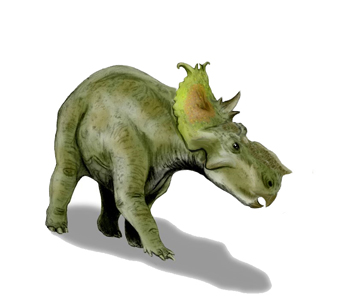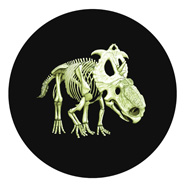June 7, 2012 – Among other new issues the Royal Canadian Mint has released a 25 cent collector coin that features high technology as the Mint uses its first-ever glow-in-the-dark collector coin to shed a new light on the lost world of prehistoric animals. The Pachyrhinosaurus Lakustai is the first in a four coin Prehistoric creature glow-in-the-dark series – and sold out yet!
The Mint has worked with a technology partner to develop a sophisticated new photo-luminescent coin.
Pachyrhinosaurus lakustai, a ceratopsian from the Late Cretaceous of North America, pencil drawing, digital coloring by Nobu Tamura /Wikipedia.
The subject of this groundbreaking coin is the famed fossil of Pachyrhinosaurus Lakustai, first discovered by science teacher Al Lakusta at Pipestone Creek, Alberta. In addition to discovering a new dinosaur species, Lakusta located a fabulous deposit of prehistoric bones which Alberta’s famed Royal Tyrrell Museum of Paleontology has been excavating and preserving since 1986.
The new coin as it appears in the light and in the dark.
In the spirit of celebrating Canadian advances in understanding the prehistoric era, the Mint produced a painted image of a living Pachyrhinosaurus Lakustai on a 35 mm cupronickel coin over which its proprietary photo-luminescent feature cleverly reveals the skeleton of this Late Cretaceous creature when the coin is placed in darkness. Both the living and skeletal views of this dinosaur are the work of paleoartist Julius T. Csotonyi.
This theme of obvious appeal to youth and children is brought to life for the enjoyment and education of Canadians of all ages by telling an important story of Canada’s global leadership in the discovery study of prehistoric fossils. Limited to a world-wide mintage of only 25,000 coins, this exciting new collectible will be joined by three other issues in a four-coin series.
For more information on the Royal Canadian Mint and its products, please visit the mint’s website.
If you are interested in scientific references to this prehistoric creature, you will find them in the Paleobiology Database.
A bit less scientific is that video showing, however, many reconstructions and remainings in museums with some explanation.







